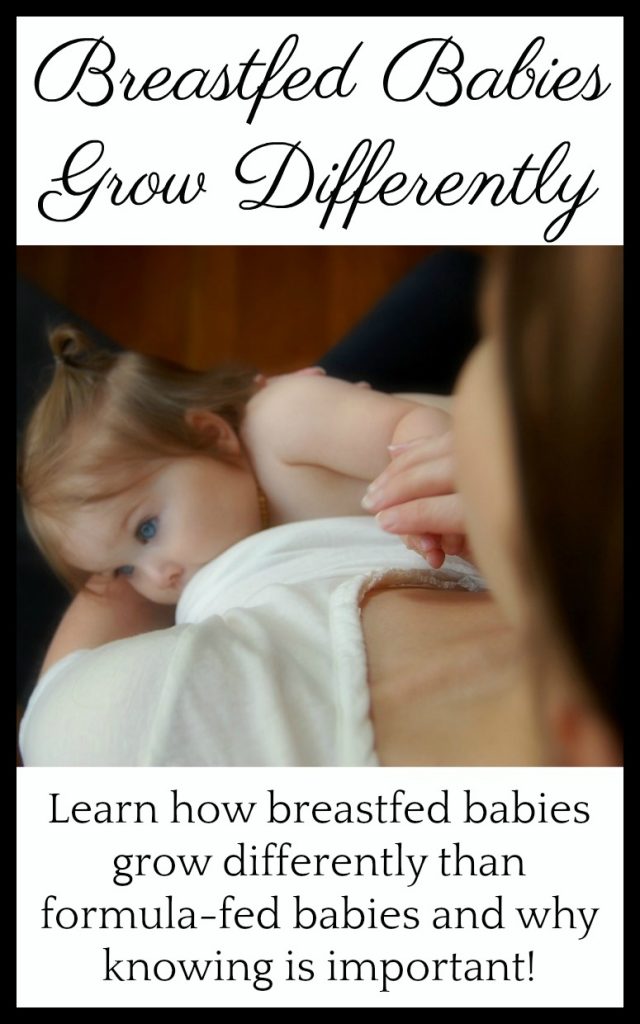I step on the scale and weigh just myself. Step on the scale with my 9 month old daughter and weigh both of us. What? Really? Maybe I did the math wrong. Re-check math, nope it’s correct. Maybe I should re-weigh us, nope same number. Hmmm that seems lighter than I was hoping she’d weigh. I get on the internet and pull up the CDC growth chart. Oh my gosh! She’s not even ON the charts now! (For the record she was only in the 15% at 6 months)
I wanted to weigh my daughter before her 9 month appointment with the doctor. Just to prepare myself for how things will be at the doctor’s. I’m an overly curious mama I guess, plus my daughter is my first exclusively breastfed baby. Now however, I go into panic mode. Why in the world is she not gaining as much as she should? I know she’s a slow gainer but really? She’s dropping off the charts?
Did you know that breastfed babies grow differently than formula-fed babies? Yes, it’s true. Breastfed babies tend to be bigger than formula-fed peers in their first few months and then from around 6 months on it switches and formula-fed babies are the bigger ones.

Why It’s Important to Remember that Breastfed Babies Grow Differently
- If you are a mama like me who likes to weigh your baby at home, it means you will know that your baby isn’t dropping off the charts suddenly.
- There are times when a doctor sees a baby in the first few months and recommends that mom doesn’t breastfeed as much. Why? Because the baby is big! Well, big on the CDC chart anyway. However, if you know that a breastfed baby grows bigger than a formula-fed baby in those first few months, then you know that your baby is probably just fine. You just need a better chart!
- Time and time again a doctor will be completely fine with how a breastfed baby is gaining until around that 6-9 month mark. Suddenly, it appears that your baby isn’t gaining weight like she should and you are sent home with a can of formula and instructions to start supplementing. The problem is your doctor is probably using the wrong chart!
Most doctors use the CDC Growth Chart for babies. The CDC chart is based on a high formula-fed population however. Therefore, when your breastfed baby is being compared to this chart it does look like she is falling off the charts.
“Perhaps their breastfed baby isn’t falling off the charts, perhaps they do not need that formula.” Click to Tweet
The good news is that the World Health Organization developed a new growth chart based on predominately breastfed children. This chart gives a realistic look at how a breastfed baby grows. Because the WHO site is a bit confusing, at least it is for me and it’s in metric. I’ve save you some of the clicking and posted the links to the WHO charts (from the CDC site…so yes it says CDC but it IS the WHO chart. CDC is now listed both charts on their site. Weight-for-age Percentiles for Girls Birth to 2 years and Weight-for-age Percentiles for Boys Birth to 2 years.
If you are interested to see the difference between the CDC and WHO charts check out Kellymom’s comparison. You can clearly see that breastfed babies do not grow like formula-fed babies.
My real reason for writing this post is to help others understand that perhaps their breastfed baby isn’t falling off the charts, perhaps they do not need that formula. (Note: I definitely do not want to sound like I’m saying you should never supplement with formula; there are definitely times when it is needed. I’m just saying that you might want to compare charts before you buy that can of formula. Also note, there are actually 5 options for if you can’t breastfeed and only one is formula!) If your doctor is concerned that your breastfed baby isn’t gaining as much as they should, ask your doctor what chart they are using! Odds are it’s the CDC chart. Check the WHO chart instead and then see if your baby really is falling off the charts.
Perhaps your doctor is fine with where you baby is measuring but YOU are worried. What mom hasn’t felt that nagging fear that perhaps your baby isn’t growing properly? The WHO chart can definitely relieve some of that worrying. That is what I had to do! As I said, according to the CDC chart my daughter had fallen well below the weight chart. However, on the WHO chart she is hold steady on her petite 15%. Worried mama put to ease.
FTC DISCLOSURE: In order for me to support my blogging and social media activities, I may receive monetary compensation for my endorsement, recommendation, reviews and/or link to any products or services from this article. However, I only recommend products or services I feel are up to my standards. The Pistachio Project’s a participant in the Amazon Services LLC Associates Program, an affiliate advertising program designed to provide a means for sites to earn advertising fees by advertising and linking to Amazon.com.
All information on The Pistachio Project is meant for educational and informational purposes only. The statements on this website have not been evaluated by the Food and Drug Administration. Products and/or information are not intended to diagnose, cure, treat, or prevent any disease. Readers are advised to do their own research and make decisions in partnership with their health care provider. If you are pregnant, nursing, have a medical condition or are taking any medication, please consult your physician.
Original article and pictures take djyap9dtmy29a.cloudfront.net site
Комментариев нет:
Отправить комментарий